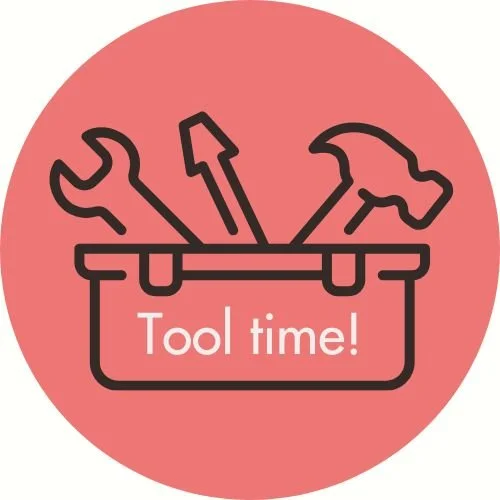How to talk to your adult child about their future plans and goals
This guide isn’t theory. It’s shaped by years of coaching sessions, real conversations, and the practical shifts that people tested until they found what actually works.
You want to support your adult child's future.
But "support" can mean different things to you, like offering guidance, staying connected, or even just avoiding arguments. The first step to making this work is to figure out why conversations aren't working right now, and then you can work on it.
Scan the list of reasons below and click the one that feels most like you to jump to that section:
- “Every conversation turns into an argument.”
- “They shut down when I bring up their future."
- “I don't understand their generation's approach."
- "They seem completely directionless and unmotivated."
- "I'm afraid they'll make the same mistakes I made."
- "They won't listen to any advice I give."
- "I don't know when to step back versus when to help."
“Every conversation turns into an argument.”
Having productive conversations about the future involves using a few simple skills that work together to help you connect and communicate better. These skills include:
Listening first: This means hearing their perspective completely before sharing your thoughts. It helps you understand their viewpoint and shows respect for their autonomy.
Asking questions instead of giving advice: After listening, asking open-ended questions like "What feels most important to you?" helps them think through decisions rather than feeling lectured.
Timing conversations well: Instead of ambushing them during stressful moments, find calm times when you're both relaxed and have privacy.
Managing your emotions: Staying curious (rather than anxious) keeps conversations from escalating into power struggles.
Many parents think that sharing wisdom or giving direct advice is enough, but these methods often trigger defensiveness in your child, causing them to shut down because they feel controlled rather than supported.
Imagine your relationship as a bridge between two islands. Each time you listen first and ask questions (instead of pushing your agenda), you add a plank to that bridge and make it stronger. If you only talk at them without walking across to their side first, the bridge stays incomplete and shaky.
So, when someone says, "Every conversation turns into an argument," it often means they know the goal (helping their child succeed) but haven't been taught the steps to reach it. Learning how to combine these smaller skills (listening, questioning, timing, and emotional regulation) can make conversations more productive and less frustrating.
One parent I worked with told me, "I always start with what I think they should do, and within minutes we're yelling." Once they learned to ask "What's on your mind about work lately?" first, they were able to have deeper conversations while arguing less.
Start with these quick wins
Start with a question, not advice: Open with “I’m curious what feels most important to you right now.” Listen fully before you respond.
Why it works: Leading with curiosity signals respect for their autonomy. When people feel heard rather than judged, they're more likely to open up and consider new perspectives.
Ask three questions before giving advice: Before sharing any advice, ask three genuine questions about their situation. Only offer thoughts if they ask for them.
Why it works: Questions help them think through problems themselves, which leads to better decisions. It also prevents you from solving problems they didn't ask you to solve.
Schedule the talk: “When would be a good time to chat about your plans?” Honor the time they choose.
Why it works: Scheduled conversations feel collaborative rather than intrusive. When people choose the timing, they're mentally prepared to open up instead of feeling ambushed.
How to run a short planning chat
Text ahead of time: “Could we do a 15-minute check-in tonight at 7:30 to plan one small step for the next two weeks?”
Then (when you meet) ask, one at a time:
“What would feel like progress in the next two weeks?”
“What would make that easier?”
“What exact step will you try, and on which day?”
“When will we review it?”
Write together: “By [date]: [one step]. Review at [time].”
If it drifts: “Let’s finish this plan, then we can schedule time for the other topic.”
TOOLS AND RESOURCES
This guide is designed to help you actually talk with your adult child about what’s next for them, without the eye rolls, shutdowns, or storming out. Inside, you’ll get ready-to-use conversation openers, tension-diffusing scripts, and reflection prompts to help you show up calm, grounded, and ready to connect (not control). Click the image to learn more about it.
Books worth exploring:
*How to Talk So Adult Children Will Listen & Listen So Adult Children Will Talk by Adele Faber and Elaine Mazlish: Grounded in decades of family communication research, it shows why listening first and respectful dialogue are so effective.
*Boundaries by Dr. Henry Cloud and Dr. John Townsend: A practical guide with strategies for healthy parent-adult child relationships that high-functioning families actually use.
*Heads-up: Some of the links on this page are affiliate links, which means I may earn a small commission if you choose to make a purchase, at no extra cost to you. I only recommend tools and resources I genuinely believe are helpful. Thank you for supporting the work I do here.
"They shut down when I bring up their future."
“Future planning” conversations require emotional safety, but safety is fragile. Your adult child's brain isn't designed to handle pressure about major life decisions gracefully. It naturally goes into defensive mode when conversations feel judgmental, which is why trying to discuss their future during stressful moments often backfires. On top of that, your emotional state (worry, frustration, disappointment) gets transmitted to them and pulls them away from their ability to be open.
Here are some of the smaller skills that work together to create emotional safety:
Managing your own anxiety: Instead of letting worry drive the conversation, take time to calm yourself first. This matches how healthy communication naturally works.
Creating low-pressure environments: That means bringing up future topics during relaxed moments, maybe while cooking together or taking a walk, when judgment feels less likely.
Building on small topics first: A short conversation about their current job satisfaction signals that you can handle bigger future discussions without panicking.
Respecting their processing style: Some people need time to think before sharing. A rushed conversation can make them feel cornered.
Think of emotional safety like a thermostat in a room. If the temperature is too hot (high pressure, anxiety, judgment), people shut down to protect themselves. But if you adjust the climate (stay calm, show patience, reduce stakes), what they're feeling comes into a comfortable range for sharing.
One parent I coached admitted, "Every time I ask about her career, she leaves the room." When they started with smaller questions like "How was your day?" and genuinely listened without an agenda, their child began opening up about bigger topics naturally.
Start with these quick wins
Temperature check: Before bringing up topics about their future, take a beat to notice your own stress level. Take three deep breaths and remind yourself this is one conversation, not their whole life.
Why it works: Your emotional state is contagious. When you're calm, they will feel safer to be vulnerable and honest.
Side-by-side setup: Have conversations while doing something together, like cooking, walking, or driving. Avoid those face-to-face "serious talks."
Why it works: Side-by-side activities reduce the intensity and make conversations feel more natural and less like interrogations.
Permission to pause: Say "No pressure to answer now" when asking about their future plans. Let them know they can think about it. If they say no to answering now, ask to pick a time that works or offer a quieter format like texting or a shared note.
Why it works: Removing time pressure creates psychological safety. They can engage without feeling cornered or judged for not having immediate answers. It also shows that you trust they can have their own thoughts about their future.
TOOLS AND RESOURCES
Books worth exploring:
*The Gifts of Imperfection by Brené Brown: Explores why shame and fear kill connection and how to cultivate vulnerability and courage in family relationships.
*Hold Me Tight by Dr. Sue Johnson: Offers research-based strategies to improve emotional connection and reduce defensive patterns in close relationships.
*Heads-up: Some of the links on this page are affiliate links, which means I may earn a small commission if you choose to make a purchase, at no extra cost to you. I only recommend tools and resources I genuinely believe are helpful. Thank you for supporting the work I do here.
"I don't understand their generation's approach."
Generational differences can bring people together, but calling them "wrong" creates walls between us.
Many parents get caught in one of two traps:
Comparison: You see how your generation handled career planning and assume they should too. Suddenly, their different approach feels like failure.
OR
Dismissal: You believe your way is the only practical way. That makes listening terrifying, because validating their approach feels like abandoning your values.
To see things more clearly, use simple mental skills that change how you view differences between generations:
Getting genuinely curious: Learning about their generation's challenges and opportunities without immediate judgment.
Finding common ground: Both generations want security and fulfillment, even if the paths look different.
Separating methods from values: They may value the same things you do (stability, growth, contribution) while choosing different strategies.
Generational differences are like two people climbing the same mountain from different trails. You might be taking the "established path" while they're finding a "new route." Both can reach the summit, just with different views along the way.
One parent once told me, "If they don't follow a traditional career path, they'll never be secure." Once they learned that their child valued security too, but defined it differently (flexibility over stability), they stopped feeling threatened and started feeling curious.
Start with these quick wins
Ask about their world: "What's different about your generation's job market compared to mine?" Listen to learn, not to debate.
Why it works: Understanding their context helps you see their choices as adaptive rather than lazy or unrealistic.
Find the shared value: Instead of focusing on different methods, identify what you both care about underneath (security, happiness, meaningful work). e.g., “We both care about security, even if we define it differently.”
Why it works: Common ground creates a connection. When you both want the same outcome, different paths feel less threatening.
Separate advice from love: You can love and support them without agreeing with every choice. Say "I love you and I trust you to figure this out."
Why it works: Unconditional support lets them make their own mistakes and learn from them, which builds confidence and strengthens your relationship.
TOOLS AND RESOURCES
Books worth exploring:
*The Coddling of the American Mind by Greg Lukianoff and Jonathan Haidt: Helps understand generational differences in resilience, challenge-seeking, and approaches to safety and growth.
*iGen by Jean M. Twenge: Research-based insights into how the smartphone generation thinks differently about work, relationships, and life planning.
*Heads-up: Some of the links on this page are affiliate links, which means I may earn a small commission if you choose to make a purchase, at no extra cost to you. I only recommend tools and resources I genuinely believe are helpful. Thank you for supporting the work I do here.
"They seem completely directionless and unmotivated."
A lack of direction isn’t usually about laziness. Often, it’s because your child feels overwhelmed. When they see many career paths and life choices, plus the pressure to "figure it out," it can feel scary. This overwhelm can make them shut down and want to do anything else instead. Social media comparisons ("Everyone else knows what they’re doing") can make them seem unmotivated.
Another problem is analysis paralysis: having too many options and no clear way to choose. Without breaking big decisions into smaller, low-risk steps, it’s easy to get stuck until outside pressure forces a choice.
Think of directionlessness like standing in front of a huge menu at a restaurant. If the only option is to order the "perfect meal for your whole life," you'll freeze. But if you focus on trying one appetizer, the choice suddenly feels manageable.
Many parents have told me, "They just need to pick something and stick with it." But when we dug deeper, they admitted their child was anxious, overwhelmed, and comparing themselves to others. Once parents learned to suggest small experiments instead of major commitments, their children discovered that "lack of direction" wasn't laziness; it was decision paralysis.
Start with these quick wins
Suggest small experiments: Instead of "What do you want to do with your life?", try "What would you be curious to try for three months?"
A 7-day trial to test a direction:
Day 1: Choose one idea to try for one week.
Day 2–6: Do the smallest version twice. Write one sentence after each try: what helped, what got in the way.
Day 7: Decide to keep it, change it, or drop it. If keeping it, pick the next tiny step for two more weeks.
Why it works: Small experiments reduce the pressure of permanent decisions. Movement creates momentum, and momentum often reveals direction.
Read: Micro-experiments: The secret to finding what you love
Celebrate exploration: Acknowledge when they try new things, even if they don't stick with them. "I'm proud of you for trying that internship."
Why it works: Positive reinforcement for exploration encourages more exploration. The goal is learning about themselves, not committing forever.
Ask about energy, not passion: "What activities give you energy?" is easier to answer than "What's your passion?"
Why it works: Energy is more concrete and observable than passion. It's also a more reliable guide for sustainable career choices.
TOOLS AND RESOURCES
Books worth exploring:
*Designing Your Life: Build a Life that Works for You by Bill Burnett and Dave Evans: Uses design thinking principles to help people navigate career uncertainty through prototyping and experimentation rather than perfect planning.
*Heads-up: Some of the links on this page are affiliate links, which means I may earn a small commission if you choose to make a purchase, at no extra cost to you. I only recommend tools and resources I genuinely believe are helpful. Thank you for supporting the work I do here.
"I'm afraid they'll make the same mistakes I did."
Fear can push helpful parenting off track. When your protective instinct goes into overdrive, energy shifts away from the parts of your brain responsible for trust and connection. That's why you can be supportive in general but controlling during future-planning conversations; your nervous system thinks their choices are threats to their wellbeing.
Perfectionism makes this worse. If every potential mistake feels catastrophic, you'll parent in a constant state of anxiety. Without fear-management habits, guidance stops being helpful and starts being suffocating.
Think of it like trying to teach your child to ride a bike while gripping the handlebars yourself. Until you let go of control, they can't develop their own balance.
A parent I worked with once told me, "I see them heading toward the same dead-end career I had, but they won't listen." We practiced separating their story from their child's story, and they learned to share their experience without demanding their child avoid all similar choices. The relationship improved, and ironically, their child became more open to their perspective.
Start with these quick wins
Share story, not prescription: "Here's what I learned from my experience..." instead of "You absolutely cannot do X."
Why it works: Stories invite consideration without triggering rebellion. People learn better from examples than commands.
Fear check: Before giving advice, ask yourself: "Am I responding to their actual situation or my old fears?"
Why it works: Separating past from present helps you respond to their real needs instead of your historical wounds.
Trust building: Remind yourself of times they made good decisions. Say, "You've shown good judgment before; I trust you with this too."
Why it works: Expressing confidence builds their confidence. People often rise or fall to meet our expectations of them.
TOOLS AND RESOURCES
Books worth exploring:
*The Blessing of a Skinned Knee by Wendy Mogel: Helps parents understand how protecting children from all mistakes actually weakens them, and how to support resilience instead.
*Heads-up: Some of the links on this page are affiliate links, which means I may earn a small commission if you choose to make a purchase, at no extra cost to you. I only recommend tools and resources I genuinely believe are helpful. Thank you for supporting the work I do here.
"They won't listen to any advice I give."
When advice falls flat, it’s usually because of a few simple things. Fix these, and you’ll be heard more often:
No permission: Advice that arrives uninvited feels like pressure. Ask first, then wait for a yes or a no.
Bad timing: If they are tired, busy, or stressed, even good ideas land poorly. Choose a time on purpose.
Too much, too vague: Long speeches and abstract tips are hard to use. Offer one idea in plain words.
Wrong level: Advice that is three steps ahead creates resistance. Match their current step.
No choice: People follow through on what they choose. Give room to edit or decline.
Start with these quick wins
Ask permission first: “I have a thought that might help. Want to hear it? It’s 60 seconds, and if it misses, we’ll drop it.” Wait for a yes before sharing advice.
Why it works: Permission creates mental readiness to receive input. People listen better when they've opened the door.
Understand before advising: Ask three questions about their situation before offering any suggestions. Really listen to their answers.
Why it works: Understanding their reality helps you give relevant advice. Generic wisdom feels dismissive.
Share options, not orders: "One option might be..." or "Some people try..." instead of "You should..."
Why it works: Options feel collaborative while orders feel controlling. People are more likely to consider ideas that preserve their autonomy.
Example:
Before:
You: “You should apply to five jobs this week and fix your resumé first.”
Them: “Please stop. I’ve got it.”
After:
You: “I have a thought that might help. Want to hear it? It will take 60 seconds.”
Them: “Okay.”
You: “For the next two weeks, try one small step: update the top part of your resumé and send two applications. It keeps it small but moves you forward. Does that feel doable, or would you change it?”
Them: “Two is fine. I’ll do one on Tuesday and one on Friday.”
You: “Great. Want me to proofread the summary, or are you good?”
Them: “Proofread, please.”
TOOLS AND RESOURCES
Books worth exploring:
*The Trusted Advisor by David H. Maister, Charles H. Green, and Robert M. Galford: While focused on business relationships, its principles for building trust and earning the right to influence apply perfectly to parent-adult child relationships.
*Heads-up: Some of the links on this page are affiliate links, which means I may earn a small commission if you choose to make a purchase, at no extra cost to you. I only recommend tools and resources I genuinely believe are helpful. Thank you for supporting the work I do here.
"I don't know when to step back versus when to help."
Once your child becomes an adult, your roles (parent and child) have to change. Your new relationship with them is like managing a changing partnership. Confused boundaries, unclear roles, and uneven support can hurt your connection. Each time you overstep or micromanage them, trust drops, and both of you will feel confused and maybe even resentful.
Having clear boundaries can also mean how you communicate. Offering help without being asked or ignoring their choices makes it hard to keep a healthy relationship. Without clear roles, you waste energy on confusion instead of enjoying each other.
It’s like dancing without knowing who is supposed to lead. That’s how parent-adult child relationships feel without clear boundaries.
Read: Want to stop enabling your adult child financially?
One parent I worked with had a 25-year-old still living at home, but who wanted full independence. We figured out the problem was boundaries. After an honest talk with their child about expectations, contributions, and timelines, both felt much less stressed.
Start with these quick wins
Ask about your role: "How can I best support you with this?" instead of assuming you know what they need.
Why it works: Direct communication about roles prevents assumptions and resentment. They can tell you exactly how to help.
Offer once, then respect the answer: Make your offer to help clear, then honor their yes or no without repeated suggestions.
“If you want help, I’m happy to do [specific thing] for two weeks. We’ll check on the 15th, and you can decide if you still want that help.”
Why it works: Respecting their response builds trust in your ability to hear them. Multiple offers feel like pressure.
Check in without fixing: "How are things going with your job search?" without immediately offering solutions.
Why it works: Sometimes people need emotional support more than practical advice. Listening without fixing shows love and builds connection.
TOOLS AND RESOURCES
A unique online program that helps families with young adults who still live at home, make living together easier. Within 4 months, without fighting, pressuring, or enabling, you and your family can learn to live together peacefully while the teen or young adult transitions to independence. Learn how to communicate with each other with respect and understanding.
Books worth exploring:
*Boundaries: When to Say Yes, How to Say No to Take Control of Your Life by Dr. Henry Cloud and Dr. John Townsend: Classic guide to understanding healthy boundaries in all relationships, including with adult children.
*Heads-up: Some of the links on this page are affiliate links, which means I may earn a small commission if you choose to make a purchase, at no extra cost to you. I only recommend tools and resources I genuinely believe are helpful. Thank you for supporting the work I do here.
Share this guide on Pinterest.
Every parent has a different gap. Yours might be communication skills, emotional regulation, generational understanding, fear management, advice-giving, or boundary-setting. The answer isn't to try harder; it's to notice where you're getting stuck and match it with the right approach.
Start with one of the quick wins today. Then, try the tools that speak to your gap so you're not just caring more, you're connecting better.
FAQ: Talking to your adult child about their future plans
-
Every one to two weeks is enough. Keep it to 15-20 minutes, end with one small step and a review date.
-
Accept the no. Ask to pick a better time or offer a calmer format, such as a short text exchange or a shared note.
-
State your intent and ask permission: "I'm not here to judge. Can we plan one small step for the next two weeks?"
-
Stay with one goal and a short time frame. Ask one question at a time, write the plan in one sentence, and stop there.
-
Narrow choices. Ask what to rule out, offer two simple options, or try a 7-day trial of one small step.
-
Pick a 30-day window and three visible milestones. Set a review date to decide the next month's focus.
-
Write a short agreement: what you will fund, for how long, and what progress keeps it going. Keep love separate from logistics.
-
Ask first. Stand beside for the tricky part, then step back. Make a tool they can reuse, like a template or checklist.
-
Use predictable times, shorter talks, and the format that is easiest. Plan with a simple one-page outline and fewer questions.
-
Decide who needs to be there and why. Keep the first meeting small and time-limited, and share the plan outline in advance.
-
Review on the date you set. Shrink the step, add one support, and write a new one-line plan. Keep the tone calm and practical.
-
Ask, "Do you want ideas or for me to listen?" If they want to vent, listen and end by asking whether they want to plan a small step later.













Tired of feeling obligated to help your family financially? Discover 5 clear signs your boundaries are being crossed and how to set limits with love, not guilt.